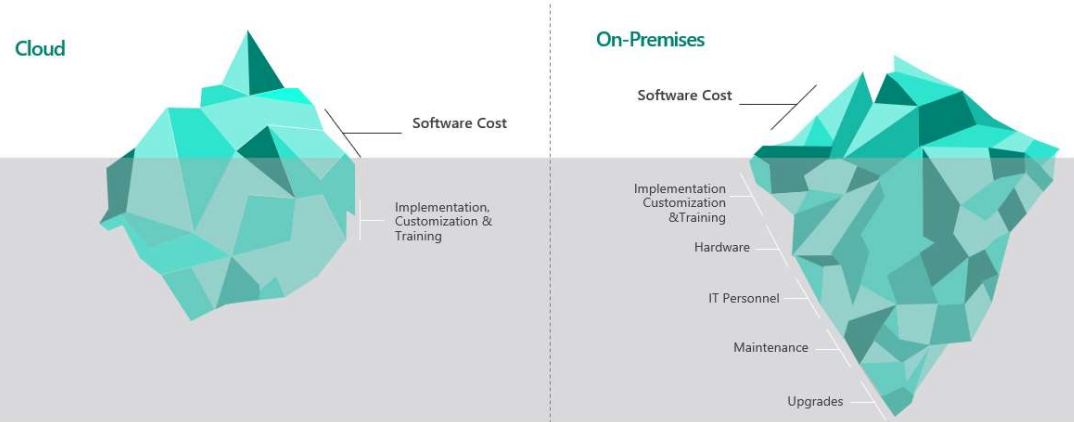Is your company evaluating whether to transition your ERP solution to the cloud or stay on-premises?
To determine whether this transition is right for your company, you’ll need to understand the economic impacts of your current ERP solution and what your ERP might look like in the cloud. Total Cost of Ownership (TCO) is a financial estimate to determine your economic value of investment against your total direct and indirect costs over your system lifecycle.
The TCO estimate considers the six cost areas every company needs to understand when visualizing their company’s transition to the cloud.
Take a look at the picture below – at first glance, cloud and on-premises solutions look the same!
Let’s go to Dive into a comparative analysis of costs between cloud and on-premises to understand exactly what Solutions for your organization.

Cloud-vs-On-Premises.
This is the cost of your software application, including the cost of all supported products and services, such as ISV solutions, add-on applications, customizations, and other integrations to power your ERP the system is fully compatible with existing systems.
One big difference in terms of licensing is that cloud is a SaaS that you pay as you use on a monthly or yearly basis and pay for costs that are classified as operating expenses (OpEx). For on premises applications, you pay a high upfront cost are classified as capital expenditures (CapEx) and are usually amortized over several years.
Implementation, customizations and training
These costs apply in both cloud and on-premises scenarios and will vary by tier complexity and use case. You will most likely need the help of a Microsoft Certified Partner to successfully
implement your ERP, so you have to consider the cost of your professional services. These implementation costs usually include software installation, parameter setting, development
customization and integration, data transfer and testing.
After the implementation is complete, you may need your Microsoft partner to train your team. Consider adding project-related costs such as solution selection, change management, process auditing, and reengineering to your TCO estimate
Hardware
In an on-premises scenario, you will incur high initial infrastructure acquisition costs such as servers, networking equipment, operating systems, databases and data stores, and then periodic
additional operating costs (such as energy costs) to efficiently operate, manage and protect your ERP solution in place. You will also need to buy more equipment and create reserves in case
failures. On the other hand, the cloud allows you to flexibly manage your hardware costs without the need for own, maintain and pay for servers regardless of the percentage of use
IT personnel
One of the biggest single line cost items is often your IT personnel budget. IT personnel have to retain Expensive, and in an on-premises scenario, you need to take into account their labor costs as well as their maintenance your real estate, servers, databases and other technology.
In a cloud scenario, some of these costs would be apply for the service, but that cost is usually a small fraction of that of maintaining your own internal IT personnel, which can result in redeploying your free resources and improving your bottom line immediately
Maintenance
Now that you know the hardware and IT staff costs, you need to include the maintenance costs your local ERP, which includes downloading patches, patches, updates and upgrades. Besides, factor in the cost of IT staff to test updates as they are released. In the cloud, updates, fixes, and fixes are released in a continuous update cycle to ensure immediate deployment.
Upgrades
In the cloud, updates run automatically in the background and require minimal IT oversight. staff, so there is no additional cost for software or updates. However, in a local scenario you will need to factor in additional IT labor costs to test and deploy updates.
Get started
Curious to know what other costs are currently not visible to you on the surface? Contact
Navisiontech today to help you benchmark your total cost of ownership. Get the knowledge you need a fully informed financial decision about the direction of your organization.
Tech Support from Navisiontech…
On-Demand and On Point
Try Navisiontech Support today! We offer 2 FREE hours of support for nearly ALL versions of Dynamics NAV, from version 3 to Business Central.
Our support team is US based and will provide support not only for your ERP system, but also for SQL Server, EDI, supply chain management tools, and even code-level support.


Leave A Comment